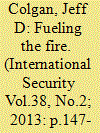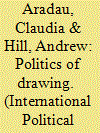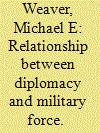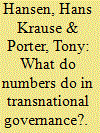|
|
|
Sort Order |
|
|
|
Items / Page
|
|
|
|
|
|
|
| Srl | Item |
| 1 |
ID:
124380


|
|
|
|
|
| Publication |
2013.
|
| Summary/Abstract |
What role does oil play in international security? While the threat of "resource wars" over possession of oil reserves is often exaggerated, the sum total of the political effects generated by the oil industry makes it a leading cause of war. Between one-quarter and one-half of interstate wars since 1973 have been connected to one or more oil-related causal mechanisms. Eight distinct mechanisms exist: resource wars, in which states try to acquire oil reserves by force; petro-aggression, whereby oil facilitates domestic political control of aggressive leaders such as Saddam Hussein or Ayatollah Ruhollah Khomeini; externalization of civil wars in petrostates; financing for insurgencies, such as Iranian oil money to Hezbollah; conflicts over potential oil-market domination, such as the United States' conflict with Iraq over Kuwait in 1991; control over transit routes, such as shipping lanes and pipelines; oil-related grievances, whereby the presence of foreign workers in petrostates helps extremist groups such as al-Qaida recruit locals; and as an obstacle to multilateral cooperation, such as when an importer curries favor with a petrostate to prevent multilateral cooperation on security issues. Understanding these mechanisms can help policymakers design grand strategy and allocate military resources
|
|
|
|
|
|
|
|
|
|
|
|
|
|
|
|
| 2 |
ID:
127054


|
|
|
|
|
| Publication |
2013.
|
| Summary/Abstract |
Drawing has been largely neglected in discussions of visuality, conflict, and violence. In 2007, the International Criminal Court accepted 500 children's drawings depicting the conflict in Darfur as contextual evidence for war crime trials against Sudanese officials. Starting from this event, and the attention that the Darfuri children's drawings have garnered internationally, this article explores the role that drawings, and children's drawings in particular, play in the visualization of conflict and violence. Rather than focusing primarily on the relation between image and text, the article argues that visuality needs to be understood as both an aesthetic and social object, whose production, circulation, and reception transform its political effects. It then shows how children's drawings are both differentially produced, and productive of difference and ambivalence, in the "truthfulness" of conflict.
|
|
|
|
|
|
|
|
|
|
|
|
|
|
|
|
| 3 |
ID:
132011


|
|
|
|
|
| Publication |
2014.
|
| Summary/Abstract |
Diplomacy and military force mutually support each other as instruments of national policy, functioning better in concert rather than as separate entities. The Cuban Missile Crisis is a useful case study of policymakers utilizing force and diplomacy synergistically. State Department efforts prior to the crisis paved the way for a unified front with Latin American neighbors against the emplacement of Soviet missiles in Cuba. With a backdrop of nuclear threats supporting the more usable capabilities of conventional air strikes, invasion forces, and blockading ships, the American threat of force made a negotiated settlement attractive to the leadership of the Soviet Union. The risks and political damage commensurate with the use of force encouraged the Kennedy administration to pursue a diplomatic solution. Military leaders tended to not consider the political effects of the use of force. President Kennedy understood the interrelationships between force and diplomacy, as did State Department leaders.
|
|
|
|
|
|
|
|
|
|
|
|
|
|
|
|
| 4 |
ID:
130913


|
|
|
|
|
| Publication |
2012.
|
| Summary/Abstract |
This study examines how numbers in transnational governance constitute actors, objects, and relationships, including relationships of power. We review the existing literatures on numbers for insights relevant to their role in transnational governance, including the ontology of numbers, the history of numbers and their role in governance. On this basis, we set out the main distinctive ways that numbers are implicated in transnational governance. We conclude that studies of transnational governance would benefit from paying more attention to the much overlooked performative role of numbers in governance processes. Numbers have properties that differ from words, and shifts from one to the other in governance, for instance in the displacement of laws or norms with risk models or rankings based on numbers, have particular effects, including political effects on states, firms, individuals, and other actors and institutions.
|
|
|
|
|
|
|
|
|
|
|
|
|
|
|
|
|
|
|
|
|